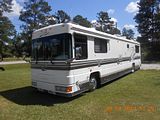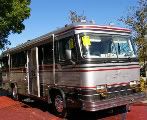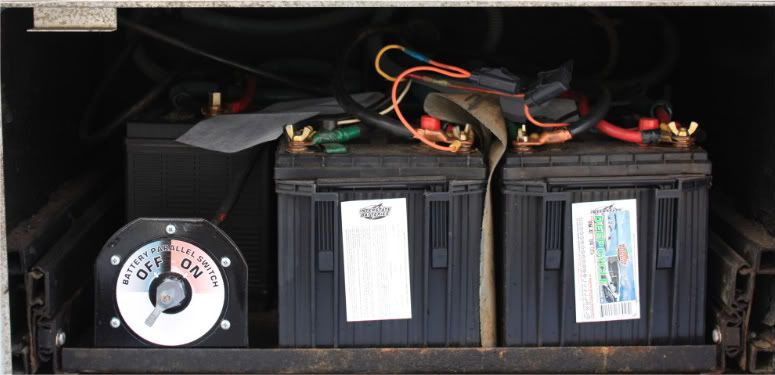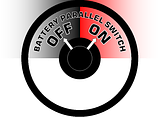Go to...  | Start A New Topic  | Search  | Notify  | Tools  | Reply To This Topic  |  |
 3/11 3/11 |
I have my Regency plugged into shore power at home (50amp dedicated circuit) and I had the automatic switch system checked last week. I told the RV place I was concerned that my chassi batteries would run down after a week even though the Intellipower system was operating and shore power was plugged in. They said it was operting properly but why dothey do that? Isn't the Intellipower supposed to keep all the battereis fully charged? Help is apppreciated. 1993 32' Regency Wide Body, 4 speed Allison Trans, Front Entry door, Diamond Plate aluminum roof & 1981 Euro 22' w Chevy 350 engine and TH 400 tranny | ||
|
 |
Tom, I can only answer that my batteries do charge and stay charged when I'm plugged into shore power. Nick | |||
|
Captain Doom |
The Intellipower with the Charge Wizard works well. If your batts are running down while plugged in, either your 12VDC load is excessive or the converter's defective. Rusty '94 28' Breakaway: MilSpec AMG 6.5L TD 230HP Nelson and Chester, not-spoiled Golden Retrievers Sometimes I think we're alone in the universe, and sometimes I think we're not. In either case the idea is quite staggering. - Arthur C. Clarke It was a woman who drove me to drink, and I've been searching thirty years to find her and thank her - W. C. Fields | |||
|
 3/11 3/11 |
I have the original Intellipower (1993) and I don't see anything that says it has Charge Wizard. Is there a chance mine is too old to have that and it may only be charging the house batteries and powering the appliances? 1993 32' Regency Wide Body, 4 speed Allison Trans, Front Entry door, Diamond Plate aluminum roof & 1981 Euro 22' w Chevy 350 engine and TH 400 tranny | |||
|
Captain Doom |
The older ones had the Charge Wizard as an option, if there's an RJ-11 (phone) jack on the unit. AFAIK, all the Intellipowers are single output, which means that, instead of having separate circuits for charging and house 12VDC, it connects to the batteries only, keeping them charged as they're used. Rusty '94 28' Breakaway: MilSpec AMG 6.5L TD 230HP Nelson and Chester, not-spoiled Golden Retrievers Sometimes I think we're alone in the universe, and sometimes I think we're not. In either case the idea is quite staggering. - Arthur C. Clarke It was a woman who drove me to drink, and I've been searching thirty years to find her and thank her - W. C. Fields | |||
|
 1/11 1/11 |
Rusty is that the red control box that leads to the batteries directly?.mine is in the motor compartment about 2ft. from the bats . lenny lenny and judy 32', Regency, Cummins 8.3L, Spartan Chassis, 1992 Tag# 9112 0158 32RS 1B | |||
|
It appears the Intellipower is not connected to the chassis batteries. I know that is the way our Breakaway is wired. When parked only the house batteries get charged. There is a momentary switch on the dash that ties them together, but it is not permanent. Sometimes if I am going to park for a period of time I run a jumper cable between the two set of batteries. So if the chassis battery is going dead within a week you have a heavy parasitic load on the chassis battery. '92 Barth Breakaway - 30' 5.9 Cummins (6B) 300+ HP 2000 Allison Front entrance | ||||
|
"Host" of Barthmobile.com 1/19 1/19 |
I installed a high amperage "Battery Disconnect Switch" to perform that same function as what Gary does. In this photo I have used a CD Disc cover and have labeled it. When I wish to parallel my batteries I just flip the switch to the right. When it is switched to the left, it will only drain down one set of batteries at a time. Likewise, it will only charge one set at a time. This is the default position while camping and not hooked up to shore power. When I am driving down the road, running the generator, or plugged in to shore power it is in the "On" position.  I do not use a battery isolator and I do not use a solenoid. Both of these items are trouble prone, each in their own way, and I have eliminated them for "The Big Switch". Here is the image I made in case someone else wishes to copy it for their use.  Click Here For A Larger Image Make sure that after you install the sticker you spray it with a can of clear gloss spray paint. Because of the snow around my coach, the clear coat on the sticker and the bright sun, this might look faded. Trust me, it isn't.  Addition notes: You'll notice something that looks like paper on the battery to the left. That is a household dryer sheet. Because of the perfume smell, it tends to keep the critters out. All batteries have a battery protection spray on the cables and the ends are color coded. My smaller gauge wires are joined with heat shrink tubing and these power wires all have a weather pack fuse holder attached to them. The 2 batteries on the right are my house batteries and the one on the left is the starter battery.
| |||||||||||||||
| ||||||||||||||||
 3/11 3/11 |
I have and update. I was following my manual thqt said Intelipower and had a statement in the Barth Book that said "To protect batteries from boiling dry wemust now wire the cut off differentlyThe converter will be wired to the "cold" side of thr olenoid. If the unit is plugged into shore power the switch at the entry door should be shut off. By doing this, the conveter eill br supplyinh power to the interior and not charging the batteries. When traveling the switch would need to be turned to Run and if batteries nned charged while on shore power can be turned On but not over a day or two" Well it turns out the actual charger is a Todd Engineering (now Iolta) 75 amp Smart Charger (according to the label). I find the shore power must be charging the start batteries because they are OK, but it also appears the house bateries arenot being charged, regardless of the switch poistion (Run or Store). While working on the generator I could not get it to start (low voltage). When I checked the house battreis they were low and I was surprised the generator gets its powerfrom the House Batteries. So now I am trying to find this Cut Off solenoid and then make it work properly. I am assuming a smart charger will take care of both sets of batreries if they are wired correctly. What am I looking for and how should the converter be connected? Thanks 1993 32' Regency Wide Body, 4 speed Allison Trans, Front Entry door, Diamond Plate aluminum roof & 1981 Euro 22' w Chevy 350 engine and TH 400 tranny | |||
|
Captain Doom |
No, that's something else TomK, if you hve a "smart" converter, it's likely an aftermarket replacement, and probably should be connected directly to house batteries. However, it's best to check the manual. Rusty '94 28' Breakaway: MilSpec AMG 6.5L TD 230HP Nelson and Chester, not-spoiled Golden Retrievers Sometimes I think we're alone in the universe, and sometimes I think we're not. In either case the idea is quite staggering. - Arthur C. Clarke It was a woman who drove me to drink, and I've been searching thirty years to find her and thank her - W. C. Fields | |||
|
 2/10 2/10 |
I have the same instruction on a page of my Barth manual (type written page) and can hear "something" click when I turn off the switch at the front of the coach. When I forget to turn it back on before disconnecting from shore power I have to reset the propane detector and the fridge stops working until I turn it back on. I haven't noticed if the start batteries have been charged from shore power. Regards Bud 1993 Breakaway 36ft & 1977 20 ft Spartan: air ride and brakes & P32(?) Cummins: 8.3 litre 250hp, PACBrake Allison 3060 (6 spd) Front entry, side hallway 7.5 kw diesel gen. 1999 2dr Tracker 4X4 5spd, SMI Braking system | |||
|
"Host" of Barthmobile.com 1/19 1/19 |
That noise is a constant duty relay. If this relay fails, and all it does is energize the coil, you will have a power draw that will run down the batteries. If this is used as a bridge for charging, then all that will happen is the coil will pull in and NO POWER will transfer to the second set of batteries. To test this theory, find the constant duty solenoid and see if it is powered up by testing the smaller wires. If it is, then check the voltage on both sides of the large cables at the solenoid. With it engaged, it should have the same voltage on both cables. For the same reason that Gary uses a jumper cable, I use a bridging switch. The reason I do not use an isolator is the voltage drop of an isolator. The reason I do not use a solenoid is the power draw associated with a hold in coil. Even if I was to change this over to a Big Boy Latching Relay that draws no power, I still will be left with the reliability of the Latching Relay. It might be a pain to bend over and turn a dial, but I feel more comfortable following a routine that proves to me it is working with no power draw. It is also easier to do this than it is to run an extra battery cable like Gary does now, and I have done in the past. It's simple, leave all the batteries bridged all of the time. The only time you unbridge the batteries is if you park your coach without it being plugged in. This way, if you kill your house batteries, you can still start your coach up. You stated... So, this is telling me that your charger is working the start batteries. In my coach the charger is hooked up to the house batteries. Regardless, if it was bridging properly it would charge both sets. This of course ass-u-mes that you have a good charger. Lets say your charger is bad. Maybe what you have is the start batteries are maintaining their charge and your house batteries are drawing down or are bad. Another option would be to install a second battery charger, one for each bank. By doing so, you eliminate the need for a bridging switch or a constant duty/latching relay. Latching Relay Post: If you have some time, read up on this post.
| |||||||||||||||
| ||||||||||||||||
| Powered by Social Strata |
| Please Wait. Your request is being processed... |
|
This website is dedicated to the Barth Custom Coach, their owners and those who admire this American made, quality crafted, motor coach.
We are committed to the history, preservation and restoration of the Barth Custom Coach.
We are committed to the history, preservation and restoration of the Barth Custom Coach.



